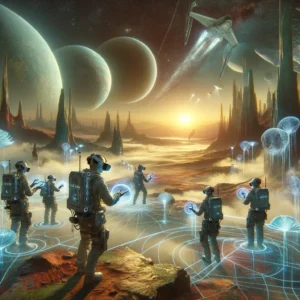In the vast expanse of the cosmos, lies an uncharted frontier waiting to be explored—the realm of Virtual Reality (VR) Expeditions Beyond Earth. Join us as we embark on an extraordinary journey to discover the wonders of outer space, from distant galaxies and celestial phenomena to the surfaces of alien worlds, all within the immersive embrace of VR technology.
I. The Cosmic Playground: Exploring the Depths of Space
1.1 Galactic Odyssey: Journeying to the Stars
Embark on a galactic odyssey through the depths of space, where distant stars, nebulae, and black holes beckon with their mesmerizing beauty and enigmatic allure. Explore the wonders of the cosmos, from the birth of stars in stellar nurseries to the cataclysmic explosions of supernovae that shape the fabric of the universe.
1.2 Cosmic Mysteries: Unraveling the Secrets of the Universe
Delve into the mysteries of the universe and uncover the secrets hidden within the cosmic tapestry. Investigate phenomena such as dark matter, gravitational waves, and the nature of black holes, as you traverse the vast expanses of space in search of answers to humanity’s most profound questions about the nature of existence.
1.3 Interstellar Travel: Navigating the Space-Time Continuum
Embark on interstellar travel adventures that defy the boundaries of space and time. Ride the waves of warped space-time as you journey through wormholes, warp drives, and hyperspace corridors to distant corners of the cosmos, where the laws of physics are stretched to their limits and new frontiers await exploration.
1.4 Alien Worlds: Discovering Exoplanets and Extraterrestrial Life
Venture to alien worlds beyond our solar system and discover the diversity of exoplanets that orbit distant stars. Explore lush forests, barren deserts, and icy moons teeming with exotic forms of life, as you ponder the possibility of encountering intelligent civilizations and communicating with beings from other worlds.

II. The Final Frontier: Lunar and Planetary Exploration
2.1 Lunar Landscapes: Walking on the Surface of the Moon
Step foot on the surface of the Moon and experience the awe-inspiring beauty of Earth’s closest celestial neighbor. Explore lunar landscapes marked by craters, mountains, and ancient lava flows, as you relive the historic Apollo missions and envision future human expeditions to establish a permanent lunar presence.
2.2 Martian Chronicles: Journey to the Red Planet
Embark on a journey to Mars, the next frontier of human exploration in our solar system. Traverse the rust-colored deserts, towering volcanoes, and frozen polar caps of the Red Planet, as you envision the challenges and opportunities of establishing a human colony on Mars and paving the way for interplanetary civilization.
2.3 Planetary Encounters: Exploring the Moons of Jupiter and Saturn
Venture beyond the confines of our solar system and explore the exotic moons of Jupiter and Saturn. Witness the icy geysers of Europa, the methane lakes of Titan, and the turbulent storms of Io, as you marvel at the diversity of worlds that orbit gas giants and contemplate the potential for life beyond Earth.
2.4 Interplanetary Expeditions: Charting the Course for Future Exploration
Chart the course for future interplanetary expeditions and envision the possibilities of human exploration beyond Earth. Consider the technological advancements, scientific discoveries, and geopolitical challenges that will shape the future of space exploration, as humanity sets its sights on the stars and seeks to fulfill its destiny as a spacefaring civilization.
III. The Human Experience in Space: Living and Working Beyond Earth
3.1 Space Habitats: Designing the Cities of Tomorrow
Explore the design and construction of space habitats that will serve as the cities of tomorrow for humanity’s expansion into space. From orbital space stations to lunar bases and Martian colonies, envision the architectural marvels and sustainable ecosystems that will support human life beyond Earth and enable long-term space exploration.
3.2 Life in Microgravity: Adapting to the Challenges of Space
Experience the challenges and wonders of life in microgravity aboard space stations and spacecraft. Discover how astronauts adapt to weightlessness, perform daily tasks, and conduct scientific experiments in the unique environment of space, as they push the boundaries of human endurance and resilience in the pursuit of knowledge and exploration.
3.3 Space Tourism: Opening the Cosmos to the Masses
Imagine a future where space tourism opens the cosmos to the masses, allowing civilians to experience the thrill of spaceflight and witness the beauty of Earth from above. Explore commercial spaceports, orbital hotels, and suborbital spacecraft, as space tourism becomes a reality and humanity takes its first steps towards becoming a spacefaring species.
3.4 Colonizing the Solar System: Building a Multiplanetary Civilization
Contemplate the future of humanity as a multiplanetary species, spreading across the solar system and beyond in search of new horizons and opportunities. Consider the ethical, social, and existential implications of colonizing other worlds, as humanity embraces its destiny among the stars and charts a course towards a bold and prosperous future in space.

IV. The Ethical and Philosophical Dimensions of Space Exploration
4.1 Ethical Considerations: Balancing Progress and Preservation
Navigate the ethical dilemmas and moral questions that arise from the exploration and colonization of space. Reflect on the responsibilities of spacefaring nations and private entities to preserve the integrity of celestial bodies, protect indigenous life forms, and uphold the principles of environmental stewardship and sustainability in the cosmos.
4.2 Planetary Protection: Safeguarding Against Contamination
Discuss the importance of planetary protection protocols in preventing the contamination of extraterrestrial environments. Examine the risks posed by human activities, robotic missions, and potential microbial hitchhikers to pristine worlds, and advocate for responsible exploration practices that minimize the risk of contamination and preserve the scientific integrity of celestial bodies.
4.3 Space Law and Governance: Establishing Rules for the Final Frontier
Explore the emerging field of space law and governance, tasked with regulating human activities in outer space and ensuring the peaceful and sustainable exploration and utilization of celestial resources. Consider the challenges of defining property rights, resolving disputes, and establishing a framework for cooperation and collaboration among spacefaring nations in the absence of national borders and jurisdictions.
4.4 The Humanistic Imperative: Reflecting on Our Place in the Universe
Contemplate the humanistic imperative of space exploration and its profound impact on our understanding of ourselves and our place in the universe. Consider the existential questions and philosophical insights that arise from the contemplation of cosmic insignificance and the search for meaning and purpose in the vast expanse of the cosmos.

